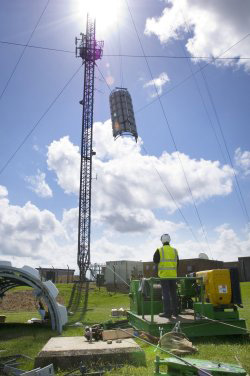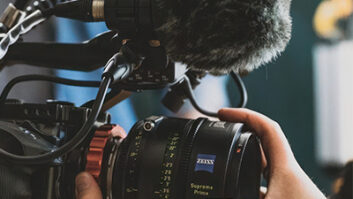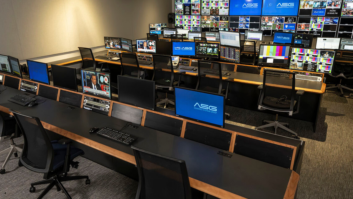
Richard Dean looks at the progress so far in the UK’s ambitious digital switchover project as the immovable deadline of London 2012 approaches.
When it comes to generating large TV audiences, you just can’t beat the grand spectacle. The glittering gold and silver of carefully orchestrated ceremonies, starring what many regard as national heroes, provides one of the best eyeball adhesives yet devised for the small screen. So compelling in fact that large numbers of people are motivated to buy a new TV set to see it – and that’s exactly what happened with the Coronation of Queen Elizabeth in June 1953, an occasion marking the mass deployment of TV sets in the UK and a step change in viewing figures.
Now a raft of consumer electronics manufacturers and broadcasters around the world are looking forward to the same phenomenon taking hold in the run-up to the London 2012 Olympics.
Of course much has changed in 59 years, not least with the introduction of 625-line colour in 1967. As we all know, it’s now the turn of this last of the analogue systems to take its final bow. But while it took some 18 years for the old 405-line black and white broadcasts to be switched off, government decided that DSO (Digital Switchover) would take place within a five-year period beginning with the sparsely inhabited Whitehaven in Cumbria on 17 October 2007.
The London area, which contains the largest number of viewers in the UK, was scheduled to be one of the last in the £700 million UK DSO project and so had a date set for sometime in September 2012. Then London won the Olympics – and the champagne had barely run dry before it became clear that a Coronation-style opportunity to maximise the benefits for digital viewers was at risk of being squandered.
Fortunately the French authorities agreed, which was important as changes to Meridian East and especially Crystal Palace – which as well as being the main transmitter serving London covers some 20% of the UK population – also affect viewers in northern France.
With French DSO brought forward almost by a year to November 2011, the London DSO could be re-scheduled in time for the Olympics, and will now be completed on 18 April 2012 – more than three months before the London 2012 Opening Ceremony on 27 July. The honour of the last DSO in the UK was to go to the Channel Islands in early 2013, but this was averted when the French agreed to an earlier switch, and now passes to Northern Ireland with its DSO late in 2012.
The company undertaking DSO – the biggest broadcast engineering project in the UK – is transmitter network owner Arqiva, which as well as changes to DSO schedules at short notice has had to deal with the worst extremes of British weather, not to mention the infamous Icelandic ash cloud furore of 2010.
Digital viewing
Television broadcasts in Wales, the west of England and most of northern England are now all-digital, and the whole of Scotland was completed on 22 June 2011. “The geography and the weather presented particular challenges in Scotland when compared to other areas of the UK,” says Peter Heslop, DSO Director at Arqiva. “For a time the ash cloud was a serious threat to the work on the Shetlands, but we managed to keep on track.
“We’re very proud at Arqiva that we’re delivering this huge engineering project on time and in budget – not many infrastructure projects on this scale can claim that. There have been many challenges but we have found solutions, sometimes pioneering ones such as the use of load-carrying helicopters to install antennas as great heights.
“We’ve also had to accommodate not only the weather but even a range of rare or endangered flora and fauna. Basically the project management has been very robust, and that’s a great credit to the DSO team at Arqiva.”
Another potential spanner in the works was the decision by government to support HD after the DSO roll-out had already begun. “It was necessary to revisit some early transmitters and relays that had already passed through the DSO process,” says Heslop.
“However we have now caught up, and HD is now available at all sites that have switched. It is also available as a temporary seventh mux from the ‘advance network’ at half a dozen pre-DSO key sites such as Crystal Palace in London and Pontop Pike in north-east England.”
HD uses the more efficient DVB-T2 transmission standard coupled with MPEG-4 compression, rather than the DVB-T and MPEG-2 regime of current SD channels, which would create HD signals that were far too bulky for practical inclusion on Freeview. Some have suggested that even SD channels should also be migrated to DVB-T2/ MPEG-4 to increase overall capacity – but as this would disenfranchise existing viewers, a more evolutionary approach seems more likely with such channels (paying for less bandwidth) possibly emerging as the penetration of T2 equipment increases.
“The digital dividend frees up some channels in the 600 MHz band which could be used for more DTT muxes — but that is up to Ofcom and who might bid for them,” says Heslop, adding that as things stand there will still be only six DTT muxes after DSO. Ofcom has already moved some PMSE, DTT and wireless mic frequencies to release the 800 MHz band in line with other European countries in preparation for the 4G auction slated for 2013.
“It’s too early to say precisely what role Arqiva will play with the provision of 4G connectivity following clearance of the necessary spectrum, but it is likely that we’ll be involved as a major site provider to the mobile operators,” says Heslop. “We are also proposing a shared wireless broadband network in rural areas using 800 MHz spectrum, which has been trialled in the Preseli Mountains in Wales.”
As Heslop explains, switchover is actually a two-stage process. “The first DSO within a given transmitter group involves replacing analogue BBC2 with a BBC digital multiplex. The remaining analogue broadcasts continue for two more weeks with captions to warn viewers of the impending withdrawal of service. Sometimes there are additional technical events that require a re-tune, as it is not always possible to adopt final DSO parameters at switchover.”
“The first DSO for the London area will happen on 4 April followed by the second DSO on 18 April 2012, with low-power DTT continuing between the two dates apart from the mux containing BBC2 which will be the new high-power service. The new muxes are typically up to 10 times more powerful than the old ones – at the first switch only the main BBC mux will increase in power, followed by the others at the second switch, subject to final DSO parameters being permitted.”
The big switch
According to Mike Hughes, broadcast director at Digital UK (the company responsible for co-ordinating and publicising DSO events), experience gained with previous switchovers – now accounting for more than 40% of the UK’s 26m households – has equipped them well for the impending big one in London.
“The London DSO is well ahead of the Olympics, and we are confident everyone will be converted to digital in good time,” he says. “Our post switchover research in other regions shows that everyone tends to switch and any niggles are sorted out within a few weeks.
“We originally thought that a four week gap would be necessary between DSO1 and DSO2, the logic being that it would give people time to switch. But it soon became clear that this was too long, as viewers are generally keen to get on with it – there is much less persuasion to go digital required than some may have expected. So we settled on a two-week gap in March 2010, the one exception being for the Channel Islands in November 2010, where we did a single stage switch as it was on a very small scale.
“Our campaign involves advertising, on-screen captions, leaflets delivered to every home three months before the first DSO and community events,” says Hughes. “We also deploy retail support teams in every live region to provide point of sale material, staff training and general advice, supported by mystery shopping. While not perfect, the standard of advice particularly in shops signed up to the digital tick scheme, is generally very good.” The BBC runs a Help Scheme for older and disabled viewers.
It’s been widely reported that some of the cheapest Freeview STBs are poorly specified, with inadequate memory affecting Red Button MHEG performance for example. “Digital UK can’t stop these from being sold, but we do have a digital tick logo scheme that guarantees a certain level of performance,” says Hughes.
“A large proportion of approved iDTVs and STBs now include a digital switch help feature, where an onscreen message prompts the user to allow retuning when significant changes are detected. In fringe areas re-tuning may have to be completed manually, but our website has instructions for most popular models.”
“We also make a point of informing viewers about the availability and benefits of added value features such as PVR and HD, and that HD-ready doesn’t mean HD without the appropriate equipment to receive the signal,” he adds.
“It’s important that the Olympics publicity and excitement does not swamp the DSO message, but I think we can count on a good deal of support from broadcasters, who naturally want to maximise their audiences. The London Olympics may have caused some of the original DSO planning to be unexpectedly brought forward, but overall I think it will help rather than hinder this essential process.”







